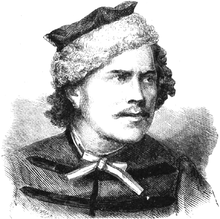This is an old revision of this page, as edited by Marcelus (talk | contribs) at 22:00, 23 November 2021 (Bolesław Kołyszko is an actual name of this person, used in historical sources, it doesn't determine his ehtnicity). The present address (URL) is a permanent link to this revision, which may differ significantly from the current revision.
Revision as of 22:00, 23 November 2021 by Marcelus (talk | contribs) (Bolesław Kołyszko is an actual name of this person, used in historical sources, it doesn't determine his ehtnicity)(diff) ← Previous revision | Latest revision (diff) | Newer revision → (diff)| Bolesław Kajetan Kołyszko | |
|---|---|
 | |
| Born | 7 August 1837 Navickiškės |
| Died | 9 June 1863 Vilnius |
Bolesław Kajetan Kołyszko (Template:Lang-lt) alias Rutkowski or Szyszka (7 August 1837 – 9 June 1863) was important participant of the January Uprising in Lithuania.
Biography

Kłyszko was born in the family of the petty nobility as a son of Wincenty Kołyszko and his wife from the Jursza family. Kołyszko graduated from the Vilnius or Lida Gymnasium and studied law in the University of Moscow, where he was part of the Polish students association called "Ogół". He was arrested in 1861 for his involvement in student demonstrations in Lida. At the end of 1861, after a short imprisonment, he emigrated to Italy, where he met Ludwik Mierosławski. First in Genoa and later in Cuneo, he studied in the Polish Military School [pl].
After the star of the uprising he went back to Lithuania. In March 1863, he organized a rebel group near Kaunas, which was joined by the groups of Bronislavas Žarskis and Antanas Norvaiša. The combined group was called the Dubysa Regiment. Koliška led his 400 men strong regiment in fights against units of the Imperial Russian Army at Aukštdvaris on March 29, near Lenčiai on April 1 (together with the unit of Tomasz Kuszłejko), near Misiūnai [lt] on April 11.
By the order of Zygmunt Sierakowski, he led a rebel column - two battalions and a cavalry unit that fought in the battle of Biržai. Kołyszko and Sierakowski's aide-de-camp Jarosław Kossakowski [pl] were supposed to take wounded Sierakowski and transport him out of the country, but they were taken prisoner on May 10. During the interogation he blamed Sierakowski for the uprising's failure and underlined that he was doing everything for the homeland. He was hanged by a court-martial on June 9, 1863.
The remains were secretly buried in Vilnius' Gediminas' Hill. They were found in 2017 during the works designed to strengthen Gediminas' Mountain [lt]. On 22 November 2019, the remains were solemnly buried in the Columbarium of the Rasos Cemetery Chapel [lt] in Vilnius.
Sources
- ^ Fajnhauz 1968, p. 368.
- ^ Fajnhauz 1968, p. 369.
- ^ "Kolyška Boleslovas Kajetonas". Istorikas.lt (in Lithuanian). 2013-09-30.
{{cite web}}: CS1 maint: url-status (link) - Maksimaitienė, Ona (2006). Boleslovas Kajetonas Koliška (in Lithuanian). Vol. X (Khmerai-Krelle). Vilnius: Mokslo ir enciklopedijų leidybos institutas. p. 372.
{{cite book}}:|work=ignored (help) - Bairašauskaitė, Tamara (2019). 1863 -1864 m. sukilėlių kelias į mirtį ir atgimimą (in Lithuanian). Vilnius: National Museum of Lithuania. ISBN 978-609-478-031-8.
- "1863–1864 m. sukilimo vadų ir dalyvių valstybinių laidotuvių ceremonija vyks 2019 m. lapkričio 22 d." kam.lt (in Lithuanian). 22 October 2019.
{{cite web}}: CS1 maint: url-status (link)
Bibliography
Fajnhauz, Dawid (1968). "Bolesław Kołyszko". Polski Słownik Biograficzny (in Polish). Vol. 13. Wrocław. pp. 84–85.{{cite encyclopedia}}: CS1 maint: location missing publisher (link)